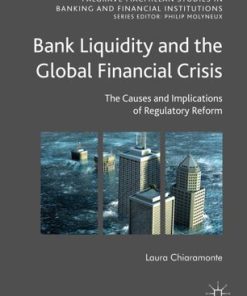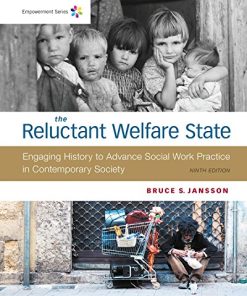(EBook PDF) European Welfare State Constitutions after the Financial Crisis 1st edition by Ulrich Becker, Anastasia Poulou 0192592696 9780192592699 full chapters
$50.00 Original price was: $50.00.$25.00Current price is: $25.00.
European Welfare State Constitutions after the Financial Crisis 1st edition by Ulrich Becker, Anastasia Poulou – Ebook PDF Instant Download/DeliveryISBN: 0192592696, 9780192592699
Full download European Welfare State Constitutions after the Financial Crisis 1st edition after payment

Product details:
ISBN-10 : 0192592696
ISBN-13 : 9780192592699
Author: Ulrich Becker, Anastasia Poulou
Hit by the European financial and economic crisis in 2008, several Member States of the European Monetary Union (EMU) were unable to refinance their public debt through the financial markets. As a result, they asked for financial assistance from international institutions and European financial assistance mechanisms. That assistance often came at a high price for citizens, cuts in pensions and social assistance, and controversial reforms in public healthcare. These far-reaching reforms were, in many cases, experienced as violations of people’s human rights. National constitutional courts, the Court of Justice of the EU, and the European Court of Human Rights issued a series of rulings on the conformity of the reforms in social protection initiated during the Eurozone crisis. This book offers a holistic analysis of the specific reforms in social protection introduced during the European financial crisis and their implications for constitutional law. Focusing on the social reforms of nine European countries that were greatly affected by the financial crisis, the volume seeks to address the legacy of the financial crisis on the application of constitutional law and the welfare state. The book will act as a helpful tool to legal academics interested in the challenges of constitutional and social law initiated by financial assistance conditionality, to advocates in quest of sound legal bases for the protection of individuals affected by social security reforms, and to national and international judges who are confronted with cases that question the legality and legitimacy of the crisis-related reforms.
European Welfare State Constitutions after the Financial Crisis 1st Table of contents:
1. Introduction
I. Starting points
II. The constitution of the welfare state under pressure
1. Social policy reforms and the financial crisis
2. Constitutional protection of social rights
a) Starting points: different meanings of social rights
b) Interplay between different legal levels
c) Mechanisms: dimensions of human rights
d) Substance: guidelines for social protection
e) Procedure: separation of powers and rule of law
III. Aim and outline of the Book
1. Aim
2. Time and area under analysis
a) Countries
b) Time frame
3. Structure of the country reports
2. Human Rights Obligations of European Financial Assistance Mechanisms
I. Introduction
II. The EU financial assistance mechanisms
III. The applicability of the Charter to EU institutions involved in the MTFA and EFSM
IV. The hybrid European financial assistance mechanisms
V. The applicability of the Charter to EU institutions involved in the EFSF and ESM
1. The applicability of the Charter to the Eurogroup
2. The applicability of the Charter to the Commission and the ECB
3. The applicability of the Charter to the Council of the EU
VI. International human rights obligations of the ESM
VII. Conclusion
3. The Transition from Welfare to Workfare in Times of Crisis: A Double-based Reform of the Hungarian Welfare State
I. Introduction
II. The main reforms and developments of the social security systems in Hungary during the last financial crisis
1. Brief outlook of the Hungarian social security system
2. Pension system after the economic crises
a) The transfer of the mandatory, private pension scheme (second pillar)
b) Fundamental changes in early retirement pension rights
3. Challenges to the statutory healthcare system
4. Transformation of ‘disability pension’ to ‘rehabilitation benefits’
5. Challenges to family policy
6. Employment and unemployment policies
III. The impact of constitutional law on the content of social security rights
1. Transition from Constitution to Fundamental Law
2. Right to social security: state goals instead of social rights
IV. Conclusion
4. The Latvian Response to Its First Economic Crisis under a Free Market Economy
I. Introduction
II. Reforms in national social security systems
1. Overview on the social security and healthcare system
2. Structural reforms and the cuts introduced after the crisis
3. Elements in the making and implementation of the reforms
a) Overview
b) Reasons for reforms
c) Procedural particularities in the making of the reforms
III. Human rights affected by social security reforms
1. National case law referring to the social security reforms
a) Overview
b) Outcome
2. Analysis of the case law
a) Role of constitutional rights
aa) Right to property
bb) Right to social security
cc) Equality
b) Role of general principles
aa) Relation to rights
bb) Legitimate expectation
c) Changes of constitutional doctrine
3. Critical assessment of the decisions
4. Role of international law
a) ECHR
b) ICESCR
c) Other sources and conclusions
IV. Conclusion
5. Upholding the Welfare State During the Financial Crisis: The Pivotal Role of the Constitutional Court of Romania
I. Introduction
II. Reforms in Romania’s social protection systems
1. Background and stages of reform
a) First stage
b) Second stage
c) Third stage
2. Specific reform measures
a) Old-age benefits
aa) Pensions pillar I
bb) Pensions pillar II
cc) Pensions pillar III
b) Unemployment benefits
c) Family allowances
aa) Social assistance benefits
bb) Social insurance allowances
d) Healthcare benefits
e) Social assistance benefits
III. Human rights affected by social protection reforms
1. Procedural issues
2. Pensions
a) Restrictions in cumulating the pension with salary income paid from state budget
b) Decrease in the amount of pensions
aa) Right to property (article 44 of the Constitution and article 1 of Protocol 1 to the ECHR)
bb) Right to a decent living standard and right to benefits
c) Removal of the non-contributive part of the special pensions
aa) Retroactive effect (article 15(2) of the Constitution)
bb) Right to property
cc) Decent living standard and securing conditions to increase the quality of life
dd) Necessity of acts of parliament
ee) Breach of other constitutional provisions
ff) Independence of the judiciary
3. Unemployment benefits
4. Other social protection benefits
IV. Conclusion
6. Salus Rei Publicae Suprema Lex Esto? Welfare State Reforms Before the Greek Courts
I. Introduction
II. Overview of the Greek social security protection systems and their reforms
1. Overview of the Greek social security system
2. Suggested and implemented reform measures
3. The Greek healthcare system
III. Constitutional and human rights affected by social security reforms
1. Procedural particularities in the adoption of the reform measures
2. Constitutional protection of the welfare state
3. Overview of the Greek system of judicial review
4. Social protection reforms before the Greek courts
a) The initial phase of judicial self-restraint
b) The milestone decisions on cuts in pensions
c) Current developments
d) The decision on the Greek PSI LM Facility Agreement
5. Assessment of the courts’ approach to social protection reforms
6. The healthcare reform before the Greek courts
IV. Conclusion
7. The Financial Crisis as a Turning Point for Constitutional Rights Jurisprudence: An Assessment of the Absence of Social Rights Protection in the Irish Constitution
I. Introduction
II. The economic crisis and crisis-related reforms
1. Economic crisis in Ireland
2. Structure, administration, and funding of social protection and healthcare
a) Structure
b) Administration
c) Funding
3. Justifying crisis-related reforms
a) Old-age benefits
b) Social assistance
c) Family allowances
d) Unemployment benefits
e) Healthcare
f) Overall assessment
III. Crisis and the Constitution
1. Institutional and procedural conditions
2. Constitutional rights impact
3. Administrative protections
4. Social protection and healthcare rights
IV. Conclusion
8. Legal Changes and Constitutional Adjudication in Portuguese Social Law in Consequence of the European Financial Crisis
I. Introduction
II. Reforms in national social security systems
1. Overview of the social security and healthcare system in Portugal
a) Social security
b) Civil servant’s social protection system: convergent social protection scheme
c) Healthcare system
2. Structural reforms and cuts introduced after the crisis
a) Old-age benefits
aa) Old-age benefits: a brief introduction
bb) Reform and cuts during the intervention
b) Social assistance
c) Family allowances
d) Unemployment benefits
e) Healthcare
aa) Sickness benefits
bb) Healthcare: National Health Service and ADSE
3. Relationship between the reforms and financial assistance commitments
III. Human rights affected by social security reforms and constitutional theoretical achievements from this period
1. National case law
a) State Budget Law 2012
b) State Budget Law 2013 and definitive cut in amount of the pensions of CGA beneficiaries
c) Decisions of 2014 and 2015
2. Critical assessment of Portuguese constitutional case law
3. The judicial protection of social rights in times of crisis
IV. Conclusion
9. A ‘Bail-In’ of Social Rights? The Cypriot Experience of the Financial Crisis
I. Introduction
II. The background of the Cypriot economic crisis and the adoption of the MoU
1. The Cypriot banking crisis and the need to restructure the welfare system
2. The uncertain legal nature of the MoU in the Cypriot legal order
III. Reforms in national social protection systems during the financial crisis
1. Overview of the national social protection and healthcare systems
a) Constitutional social protection
b) Overview of the social protection system
c) Overview of the healthcare system
2. Structural reforms and cuts
a) Old-age pension
b) Social assistance
c) Family allowances
d) Unemployment benefits
e) Healthcare
3. Grounds of justification and procedural particularities of the reforms
IV. Social protection reforms before Cypriot courts: a constitutional approach
1. Legal basis for challenging social protection cuts and reforms
2. Social protection cuts and reforms: the human rights dimension
a) The initial judicial approach: the Charalambous and Koutselini-Ioannidou cases
b) Social protection cuts and reforms and the right to property
c) Assessing the Cypriot courts’ approach to social protection reforms and human rights violations
3. Separation of powers and judges’ remunerations
V. Conclusion
10. The Outcome of the Financial Crisis in Italy: A Sea Change for the Doctrine of Social Rights
I. Introduction
II. Background
1. The 2011 ECB letter, the political crisis, and the decline of social rights
2. The constitutionalisation of the balanced budget rule
III. Reforms in national security systems
1. Preliminary remarks: social security and the healthcare system in Italy
2. Reform (and counter-reform) of the pension system
3. Reform of labour market regulation and unemployment benefits
4. The healthcare system and its underfunding
5. Social assistance under stress
IV. Human rights affected by social security reforms: the jurisprudence of the Italian Constitutional Court
1. From 2011 to 2014: the Constitutional Court and the de-prioritisation of social rights
2. From 2015 to present: the (slow) recovery of social rights
a) The mitigation of the impact of specific Court judgments
b) Budgetary constraints and the need of adequate justification
c) The hard core of social rights
d) The principle of reasonableness
V. Conclusion
11. The Predominance of a ‘Strong’ Economy over a ‘Weak’ Social Constitution: The Legacy of the Financial Crisis in Spain
I. Introduction
II. Characterisation of the reforms
1. As to the form: the ‘making-of’: the governmentalisation of the reform process
2. On the substance: arguments used to justify the reforms
a) Financial stability
b) Economic emergency
c) Gaining the confidence of the financial markets
d) Implementing policies of the European Union
III. The structural reforms
1. The retirement pension
a) Early reforms
aa) No revaluation of pensions
bb) Reform of the retirement pension
b) Decisive reforms
aa) Consolidation measures and measures to favour the continuity of the working life
bb) Sustainability factor and revaluation index of the public pension system
2. Long-term care
3. Family allowances
4. Unemployment
5. Healthcare
IV. Interpretation by the Constitutional Court
1. Constitutional evaluation of the procedural aspects of the reforms
2. Constitutional evaluation of pension reform
3. Constitutional evaluation of health reform
V. Conclusion
12. Conclusions from a Comparative Perspective
I. Legacy of the reforms with respect to social protection
1. Facts: social protection reforms
a) Pensions and healthcare
b) Unemployment and family benefits
c) Social assistance
2. Reasons: financial crisis and other drivers
3. Outcome: cutbacks and structural changes
II. Legacy of the reforms with respect to constitutional law
1. The role of constitutional law and adjudication
a) Overview
b) Objects and rights
c) Inter- and supranational sources
2. Impact of the constitution on welfare state reforms
3. Economic pressure and legal doctrine
III. The financial crisis and the constitution of European welfare states
People also search for European Welfare State Constitutions after the Financial Crisis 1st:
is europe a welfare state
european welfare states
european welfare system
european welfare
european union constitution pdf
Tags:
European Welfare,State Constitutions,the Financial Crisis,Ulrich Becker,Anastasia Poulou
You may also like…
Jurisprudence & Law
How International Law Works in Times of Crisis George Ulrich
Business & Economics
Greek Culture After the Financial Crisis and the Covid-19 Crisis: An Economic Analysis 1st Edition
Politics & Philosophy - Government & Politics
Politics & Philosophy - Government & Politics
Politics & Philosophy - Social Sciences
Gambling Policies in European Welfare States 1st ed. Edition Michael Egerer
Business & Economics - Mathematical Economics
Politics & Philosophy












